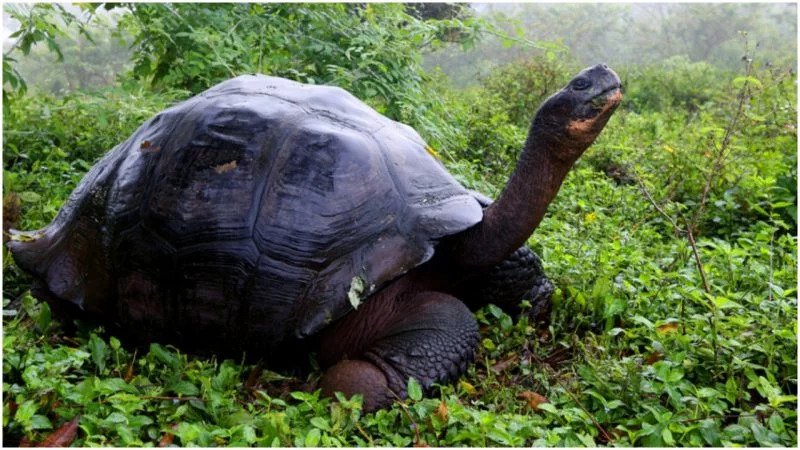‘Extinct’ Gaint Galapagos tortoise found after 100 years
After more than a millennium, a giant tortoise species from one of the Galapagos Islands, earlier thought extinct, has reappeared.
The missing animal, scientifically cataloged as Chelonoidis Phantasticus, or Fernandina Giant Tortoise, is an adult female and deemed to be over 100 years of age, according to Ecuador’s officials under whose jurisdiction the Galapagos Islands fall.

The last sighting of a Fernandina Giant Tortoise was reported in 1906. The female now appeared on the island of Fernandina where the species is native — the third largest, youngest, and most volcanically active island within the Galapagos archipelago.
According to experts, one of the reasons why this tortoise has gone missing is the active volcano looming over the creature’s habitat. Another factor has been uncontrolled hunting by humans — both for tortoise meat and oil. In fact, over the past few centuries, hunting has decimated Galapagos Islands tortoises, reducing the population by roughly 85 percent.

Upon its discovery, the Fernandina Giant Tortoise was relocated to Santa Cruz Island, another of the Galapagos islands, where it underwent health checks at a local breeding center. It has been determined that the rare specimen is in good condition, though slightly undernourished.
While the discovery has been billed as the biggest in a century for the Galapagos, it still remains for the tortoise to undergo additional genetic examinations to confirm this is really the lost tortoise species. Hopes are raised that more members of the lost species will be soon retrieved.

The tortoise was stumbled upon during an expedition carried out on the island by the Galapagos National Directorate, a U.S. non-profit Galapagos Conservancy, and Animal Planet’s ‘Extinct or Alive.’ The discovery took place on Sunday, February 16th.
Danny Rueda, who leads the Galapagos National Park, said that the discovery “encourages us to strengthen our search plans to find other turtles, which will allow us to start a breeding program in captivity to recover this species,” according to USA Today.
Only one sighting of the Fernandina species has occurred in the past — the one from 1906. This is when a single male specimen was retrieved from the island by a large expedition carried by the California Academy of Sciences.

Since then spotting other Fernandina tortoises has been an elusive job. Experts have only been able to find clues of their presence. The first time was in 1964 when a survey of remote areas of the island revealed large tortoise feces and bite-marks left on cacti. Similar traces were reported as recently as 2013.
Which is why the International Union for the Conservation of Nature (IUCN), classifies the Fernandina Island Tortoise as “Critically Endangered (Possibly Extinct).” Perhaps until now.
If no male Fernandina Island Tortoise is found for breeding, or if no surviving male semen is extracted from the female adult found just now, the species technically remains extinct.
However, as CNN reports, “Experts believe she is not alone. The tracks and scent of other tortoises, believed to be of the same species, were also observed by the team.”
The Galapagos archipelago, which consists of 19 islands located about 620 miles from the mainland of Ecuador, is world-famous for its giant tortoise inhabitants. Only one other site in the world — the Indian Ocean’s Aldabra Atoll — is known to host giant tortoise species.
The Fernandina Giant Tortoise is one of 14 giant tortoise species native to the Galapagos, of which ten species survive today. While killing tortoises has been a habitual practice in the past, today all efforts on the islands are focused on preserving and restoring the remaining tortoise populations.
The Galapagos was pronounced a national park in 1959, and as of 1978, the islands are also a recognized UNESCO World Heritage Site. The islands hold further significance for having helped Charles Darwin formulate his theory of evolution, due to their authentic flora and fauna. According to the Galapagos Conservancy website, the historical tortoise populations on the islands “was between 200,000-300,000 tortoises, and the current population is 10-15 percent of that.”

The long and slow processes of restoring those populations are reliant on methodologies such as “collecting eggs and/or hatchlings from natural nests and rearing the young in captivity, by-passing the years of highest mortality before releasing them back into the wild” writes the Galapagos Conservancy.
“As of the end of 2017, more than 7,000 juvenile tortoises returned to their island of origin — including Espanola, Isabela, Pinzon, San Cristobal, Santa Cruz, and Santiago.”
We are yet to see how the story unfolds on Fernandina Island and whether our “possibly extinct” Fernandina tortoise friend will be repopulated there. On the other corner of the world, the Aldabra Atoll remains the world’s largest shelter of giant tortoises, with population counts there showing a figure of 152,000, according to UNESCO.
